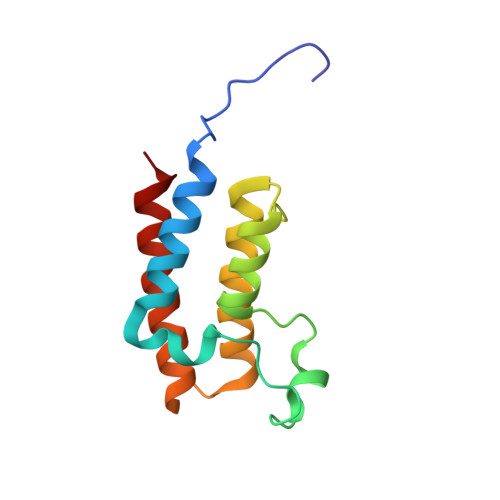Discovery and Characterization of GSK2801, a Selective Chemical Probe for the Bromodomains BAZ2A and BAZ2B.
Chen, P., Chaikuad, A., Bamborough, P., Bantscheff, M., Bountra, C., Chung, C.W., Fedorov, O., Grandi, P., Jung, D., Lesniak, R., Lindon, M., Muller, S., Philpott, M., Prinjha, R., Rogers, C., Selenski, C., Tallant, C., Werner, T., Willson, T.M., Knapp, S., Drewry, D.H.(2016) J Med Chem 59: 1410-1424
- PubMed: 25799074
- DOI: https://doi.org/10.1021/acs.jmedchem.5b00209
- Primary Citation of Related Structures:
4IR3, 4IR4, 4IR5, 4IR6, 4RVR - PubMed Abstract:
Bromodomains are acetyl-lysine specific protein interaction domains that have recently emerged as a new target class for the development of inhibitors that modulate gene transcription. The two closely related bromodomain containing proteins BAZ2A and BAZ2B constitute the central scaffolding protein of the nucleolar remodeling complex (NoRC) that regulates the expression of noncoding RNAs. However, BAZ2 bromodomains have low predicted druggability and so far no selective inhibitors have been published. Here we report the development of GSK2801, a potent, selective and cell active acetyl-lysine competitive inhibitor of BAZ2A and BAZ2B bromodomains as well as the inactive control compound GSK8573. GSK2801 binds to BAZ2 bromodomains with dissociation constants (KD) of 136 and 257 nM for BAZ2B and BAZ2A, respectively. Crystal structures demonstrated a canonical acetyl-lysine competitive binding mode. Cellular activity was demonstrated using fluorescent recovery after photobleaching (FRAP) monitoring displacement of GFP-BAZ2A from acetylated chromatin. A pharmacokinetic study in mice showed that GSK2801 had reasonable in vivo exposure after oral dosing, with modest clearance and reasonable plasma stability. Thus, GSK2801 represents a versatile tool compound for cellular and in vivo studies to understand the role of BAZ2 bromodomains in chromatin biology.
Organizational Affiliation:
Department of Chemical Biology, GlaxoSmithKline , Research Triangle Park, 5 Moore Drive, Research Triangle Park, North Carolina 27709-3398, United States.
















